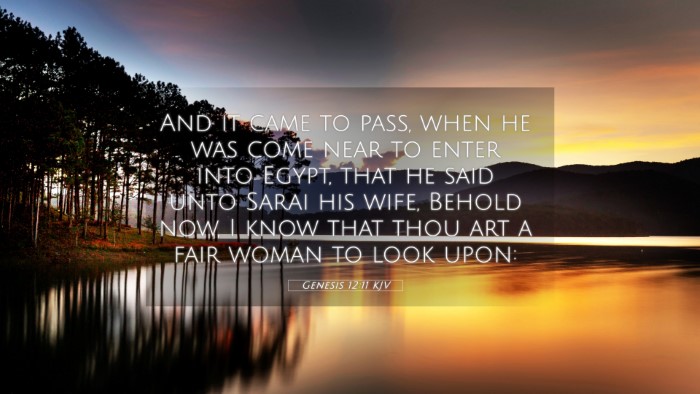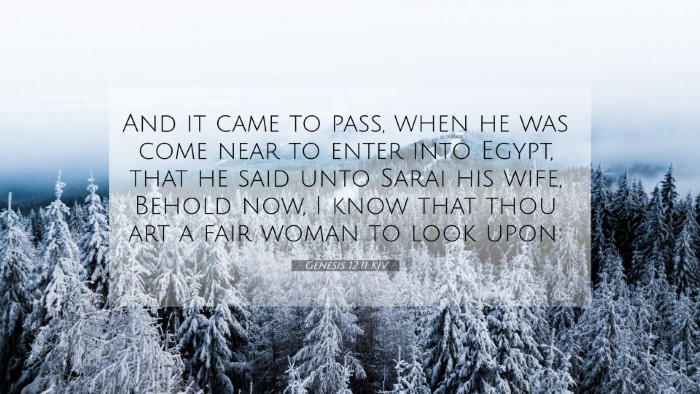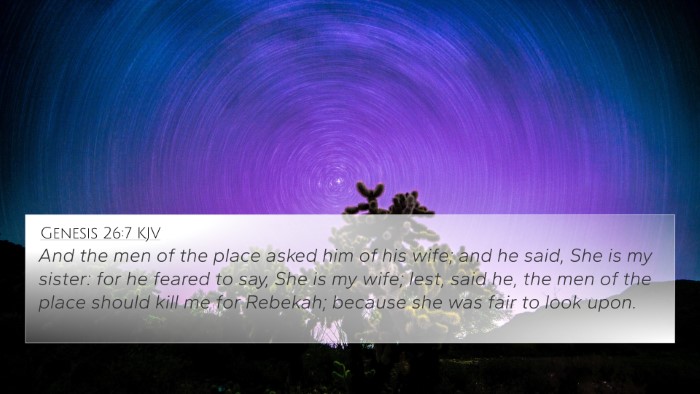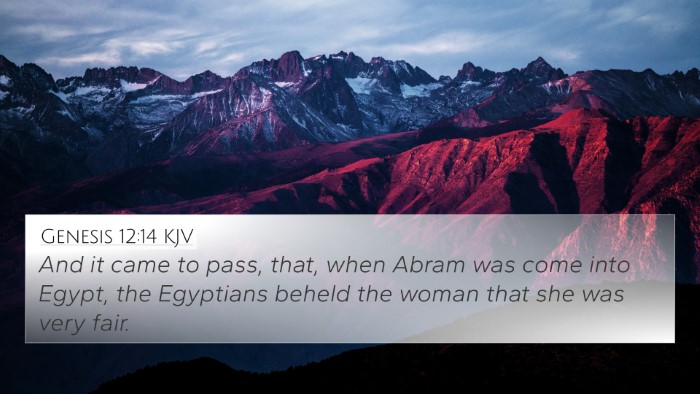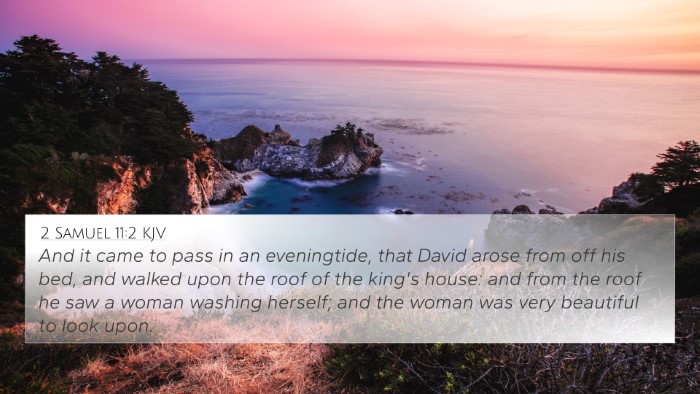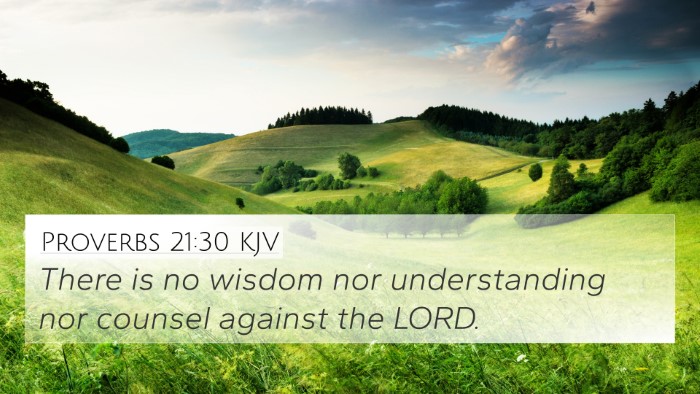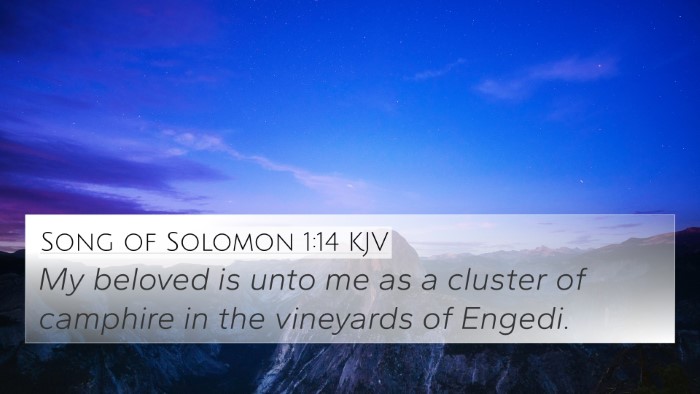Understanding Genesis 12:11
Genesis 12:11: "And it came to pass, when he was come near to enter into Egypt, that he said unto Sarai his wife, Behold now, I know that thou art a fair woman to look upon."
Summary of the Verse
This verse situates itself within the narrative of Abram (later Abraham) as he embarks on a significant journey to Egypt due to a famine in Canaan. Here, he acknowledges the beauty of his wife Sarai, which foreshadows the challenges that will arise from their sojourn in Egypt.
Commentary Insights
-
Matthew Henry:
Henry emphasizes the human fears Abram displays regarding their safety in Egypt, pointing out that his recognition of Sarai’s beauty leads him to anticipate the risks associated with her beauty in a foreign land. Abram's strategic planning reflects on the theme of fear and trust in God's protection.
-
Albert Barnes:
Barnes notes that Abram’s acknowledgment of Sarai’s beauty indicates concern for their survival, highlighting the cultural context of beauty and its potential consequences. He elaborates on the implications of Abram’s words as indicative of his character and foresight.
-
Adam Clarke:
Clarke focuses on the implications of Abram’s comments, suggesting that this moment showcases both physical beauty and the potential for moral dilemmas resulting from such beauty in a foreign land. Clarke also notes that Sarai’s beauty might have played a role in the subsequent events, linking it to the broader narrative of the Abrahamic covenant.
Thematic Bible Verse Connections
Genesis 12:11 is part of a larger narrative that can be connected to several thematic elements throughout Scripture. Below are some relevant cross-references that highlight similar themes or circumstances:
- Exodus 2:2 - The beauty of Moses’ mother leading to his preservation.
- 1 Samuel 25:3 - The description of Abigail’s beauty and understanding.
- 2 Samuel 11:2 - David's glance at Bathsheba’s beauty leads to dire consequences.
- Proverbs 31:30 - Reminds us that charm is deceptive, and beauty fleeting.
- Matthew 5:29 - A reference to the importance of guarding one’s heart regarding beauty.
- 2 Peter 3:17-18 - Advice on being cautious to avoid falling from steadfastness, linking to the risks of worldly beauty.
- Romans 12:2 - A call to transform and avoid conformity to worldly standards, connecting back to the concerns Abram faced.
Cross-Referencing Biblical Texts
The act of cross-referencing in the Bible aids in establishing deeper insights into themes, character morals, and decisions that shape Biblical narratives. The beauty highlighted in Genesis 12:11 can be related to a broader exploration of how physical attributes influence actions and their repercussions across various books of Scripture.
Applications and Reflections
When analyzing Genesis 12:11, consider the human insecurities and the factors that lead individuals to fear for their safety. Reflect on how beauty is portrayed within Scripture and the ethical dilemmas that arise as a consequence. It reminds us that while external beauty is often highlighted in narratives, the underlying integrity and trust in God’s plan are what ultimately sustain us.
Tools for Biblical Cross-Referencing
Studying Genesis 12:11 effectively requires understanding connections between Bible verses. Here are some tools and techniques to enhance your cross-referencing study:
- Bible Concordance: Useful for locating specific terms or themes across different verses.
- Bible Cross-Reference Guide: Compiles related verses for easier thematic exploration.
- Cross-Reference Bible Study: Invites deeper investigation of passages that echo similar themes or words.
- Bible Reference Resources: Various printed and digital applications that compile cross-referenced scriptures.
- Comprehensive Bible Cross-Reference Materials: Available resources that provide extensive commentary and linking of scriptures.
Conclusion
Genesis 12:11 serves as a lens through which we can examine the complexities of human relationships and the choices made under pressure. Cross-referencing with related verses illuminates the enduring themes of beauty, fear, and faith across the scriptures, guiding our understanding of God’s greater narrative and encouraging a reflective dialogue with the text.

